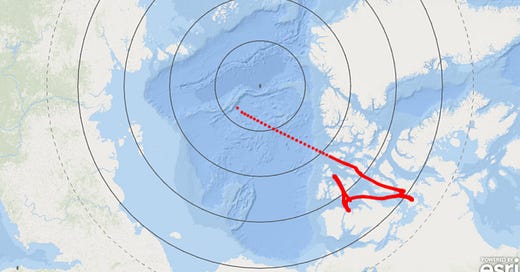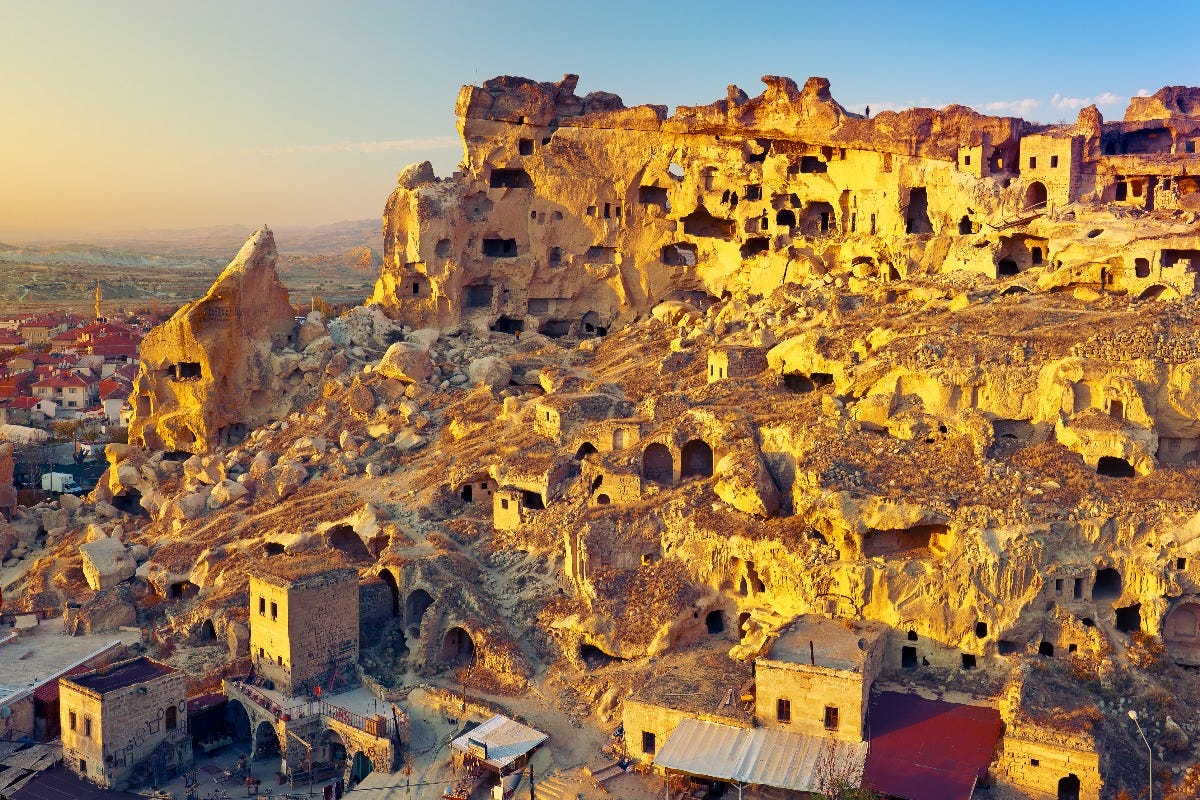Magnetic Pole Shift is Happening (part 1)
Some existential threats get more media attention than others
In just the last 20 years, the North Magnetic Pole has moved 400 miles out of Canada and into the Siberian side of the geographic pole.
In Derinkuyu, Turkey, there is an entire underground city, half a million square feet of living space extending hundreds of feet down. It was built in a time before written records — at least 6,000 years ago, but possibly much older.
42,000 years ago, the earth’s poles flipped from north to south and back, and for several centuries during the transition, there was no magnetic shield protecting the earth from cosmic rays. People and animals living on the surface would have been at high risk of radiation sickness and cancer.
Catherine Austin Fitts, Phil Schneider, and others report that a network of hundreds of underground cities connected by high-speed rail have been built as a secret US military project, funded by $ tens of trillions of missing funds in the Pentagon budget.
Is there a relationship among these four stories?
What causes the earth’s magnetic field?
The earth’s core is made of molten iron. It’s not the magnetic properties of (solid) iron that are important, but rather the fact that molten metal conducts electricity. The churning of the molten metal tends to align with the spin of the earth, and this creates a current that tends to go around the same axis. So there is a tendency for the magnetic poles to align roughly with the geographic poles, irrespective of whether the current is flowing clockwise or counter-clockwise.
The North and South magnetic poles have flipped many times during the lifetime of our planet. Geologists know this from looking for magnetization in volcanic rocks that were once molten and then crystalized at various times in the past. Every few hundred thousand years there is a pole flip, but the last one was more than 800,000 years ago. So we’re “overdue”.
What happens when the poles flip
This must be theoretical, because no one has experienced a pole flip within recorded history. Nevertheless, there is substantial consensus about the consequences.
The earth’s magnetic field weakens before a pole reversal. The field becomes more chaotic and smaller. During the pole reversal, the magnetic field almost disappears. The magnetic field had been protecting the earth’s surface from cosmic ray particles and (weaker but still highly energetic) particles from the “solar wind”. So radiation at the earth’s surface increases, and this affects the chemistry of life.
Cosmic rays are charged particles, mostly protons moving very close to the speed of light. Magnetic fields turn the course of any charged particle sideways and around in a spiral. The earth’s magnetic field deflects most of the cosmic rays that would otherwise strike the surface. Most of the rest is trapped by the magnetic field and makes landfall at the magnetic north or south pole, far from densely populated areas.
In addition to cosmic rays, which come from outside the solar system and arrive in a constant stream, there is a solar wind with similar particles, less energetic, and coming in waves depending on sunspot activity and on the direction of solar mass ejections.
Both cosmic rays and solar ejecta are capable of burning out electronic circuits. The internet will go down. Satellite communications and GPS guidance systems will fail.
Less immediately, but within a few years, there would likely be a solar storm that might have been harmless in other circumstances, but with the earth denuded of its magnetic protection, power grids would go down in large portions of the globe.
The radiation dosage at sea level would not be lethal to humans in the short term, but over a lifetime would greatly accelerate aging and increase risk of cancer.
Laschamps
The Laschamps event is by far the most recent, and by far the best studied of all the times the poles have reversed — hence a sample of one. A 42,000-year-old tree was found in Australia that was preserved in a bog, and from analysis of chemical composition (including isotopes) in the tree rings, a detailed history was reconstructed and matched against what had previously been known from geologic records.
There was a period of several hundred years during which the earth’s magnetic field weakened, disappeared, reversed, then reversed again to roughly the original (and present) configuration.
The Laschamps event occurred at the beginning of a cold spell that lasted 30,000 years. This was the most recent ice age. Whether the Laschamps event triggered the ice age is controversial.
Positive and negative feedback loops in the climate system
Was it just coincidental that the last ice age began at the same time as the earth’s magnetic field flipped and flipped again? How can a transient magnetic field change that lasted a few hundred years trigger an ice age that lasts 30,000 years? This is a big and important question and I don’t think we have a complete answer. Let me offer a hypothesis.
There are positive feedback loops and negative feedback loops within the complexity of the earth’s climate. A positive feedback loop means that if the earth starts getting cooler, the effect snowballs (so to speak) and the cooling is amplified. A negative feedback loop means that if the earth starts getting cooler, then offsetting effects are triggered that make the cooling smaller than you would otherwise expect.
Example of positive feedback loops:
When temperatures rise, the permafrost melts, releasing trapped methane, a greenhouse gas which traps more sunlight.
When temperatures fall, more of the earth is covered by ice, which reflects sunlight, further cooling the planet.
Examples of negative feedback loops:
Higher temperatures lead to more ocean evaporation, creating more cloud cover, which reflects more sunlight.
When atmospheric CO2 rises, there is more plant growth, pulling CO2 out of the atmosphere.
When CO2 is emitted into the atmosphere, the ocean acts as a buffer, absorbing CO2 (as calcium carbonate).
My hypothesis is that the positive feedback loops tend to be fast (years to centuries) and the negative feedback loops tend to be slow (centuries to millennia). Positive feedback loops can cause the climate to be stuck in a warm phase or a cold phase for tens of thousands of years, until some dramatic event reverses the trend. 42,000 years ago, that dramatic event was the Laschamps pole flip. 12,700 years ago, that dramatic event was space dust from the Milky Way impinging on our sun (according to Schoch and LaViolette) or a meteor shower that bombarded the North American ice cover (according to Hancock), dumping millions of cubic miles of water into the oceans.
Is there an effect on climate?
It is fashionable to be concerned about “global warming”. But, in fact, typical temperatures for the last million years of earth’s history are at least 6o C colder than the prevailing temperatures for all of recorded human history.
(Source)
So it is plausible that the next pole shift could end the warm era during which our civilization has grown up and flourished for 12,000 years, and plunge the earth into an ice age that is more typical of the half million years that humans have inhabited the planet.
Derinkuyu
In modern times, Derinkuyu has only been known since 1963. It is the largest of several ancient underground cities in the Capadocia region of south central Turkey. (One possibly larger has been discovered at Nevşehir,but it is not yet explored.)
The site is spread over more than 4 million square meters, of which the usable living area comprises about 50,000 square meters. There are 18 underground levels, extending 85 meters down.
There are spaces for living, for livestock, for artisans, for public gatherings. There is a sophisticated network of ventilation shafts. It is estimated that 20 - 30,000 people once lived there.
Carbon-dated artifacts found inside can tell us that a minimum age for the structure is 4,000 years, but there is no way to tell if occupants 4,000 years ago actually dug the tunnels or re-used existing tunnels. 4,000 years ago was the bronze age, when it is clear that there was no machinery and even shovels were soft metal. Since it is implausible that such an extensive project could have been constructed without machine tools, this points to a much older date, when there was a technological civilization.
Derinkuyu is not the only site hinting at an earlier technological civilization (or more than one), knowledge of which was lost in Noah’s Flood (the Younger Dryas event ended the last ice age 12,700 years ago) or in some earlier catastrophe. The Pyramids, Baalbek, Machu Picchu, the Colossus of Ramses, and the Easter Island statues also required advanced technology and machine tools. We do not have the technology today to re-create the Great Pyramid at Giza or to lift the largest foundation stone at Baalbek. There are 40,000 precision-carved stone urns in the Cairo museum that were produced by an unknown ancient technology. Solid pieces of hard, brittle stone were carved from the inside out using a technology we cannot replicate today. [more details and links here]
It is clear that there have been technological civilizations in humanity’s deep past, but they probably did not use the same kinds of technologies we have today. That’s because there is no evidence of ancient plastics or fossil fuels or steel structures or nuclear waste. It is likely there is another basis for technology that permits carving and transport of stone more easily than metal. Wouldn’t it be interesting to know how that technology worked?
So, my speculation is that Derinkuyu is 42,000 years old, from a time when the earth’s magnetic field temporarily disappeared, and people needed to spend most of their time underground to protect themselves from cosmic rays.








This is fascinating! Amazing that it doesn't get more attention. Thanks for working to change that with this excellent piece. I appreciate you recording an audio version, too!
There obviously were advanced civilisations in our distant past. As long as academic literature is stuck in the paradigm of linear development and impervious to alternative hypotheses, it will be of limited use. The same holds true for other areas, like climate change or certain areas as physics.